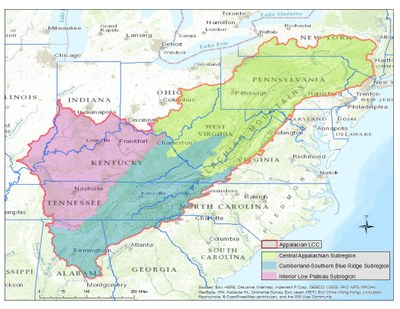Climate Change Vulnerability in the Appalachians
 The Appalachian region is rich in biodiversity that is highly threatened by energy production, development, and a host of other factors. Climate change will play out within this context, affecting habitats and species in different ways. Understanding the vulnerability of various species and habitats within the Appalachian LCC to climate change is of critical importance. Identifying the steps needed to acquire climate vulnerability information and then using this information to inform adaptation and mitigation strategies is a major research priority of the LCC.
The Appalachian region is rich in biodiversity that is highly threatened by energy production, development, and a host of other factors. Climate change will play out within this context, affecting habitats and species in different ways. Understanding the vulnerability of various species and habitats within the Appalachian LCC to climate change is of critical importance. Identifying the steps needed to acquire climate vulnerability information and then using this information to inform adaptation and mitigation strategies is a major research priority of the LCC.
The Appalachian LCC provided a grant to NatureServe to conduct critical climate vulnerability assessments. Researchers first convened a panel of climate experts to compile and review existing vulnerability assessments, compare strengths and weaknesses of methodologies used, and recommend a vulnerability assessment method for adoption. The recommended method was then deployed to generate vulnerability assessments for a suite of key species and habitats selected in consultation with partners of the Cooperative. The completed assessments are now on the Web Portal, where users can view and search by vulnerability scores, conservation status ranks, state and subregion of assessment, and higher taxonomy.
In the presentations below, Dr. Lesley Sneddon of NatureServe gives an in-depth overview of the Climate Change Vulnerability in the Appalachians research. The bulk of the presentations provide viewers with step by step instructions on how to access, utilize, and interpret the many climate change vulnerability assessments for species and habitats - both previous assessments that were assembled by the research team and new assessments that were developed for this project.























